Synopsis
The Pakistani Artist and her paintings strike the perfect balance between realism, realisation and the human struggle

Contrary to popular beliefs, an artist doesn’t always come from a place simply inclined towards socio-political commentary. More times than not, artists are grasped by personal experiences that treads into their creative work, like a fine thread embedding itself in the macro concept of it all, embellishing the end result and effortlessly connecting with the viewer in a distinctly human way. Scheherezade Junejo comes from that personal astral plane in her practice of work, delving into her past and the present, all the while prioritising the culminative human experience.
Her recent exhibition, A Feast of Flesh and Blood, showcased at Sanat Initiative, corroborated with her trajectory as an artist as it instilled the same amount of personalisation and social commentary as her previous works, building up into a rather fulfilling narrative that lets the viewer peek into the artist’s mind and question their own perspectives at the same time.
The gallery exhibit hosted a unique execution, curated by the artist Adeel Uz Zafar, where the direction was divided into two series titled Matters of the Heart and Matters of the Soul.
The former aimed to challenge the idealistic concept of romanticism and unrequited love, stemming from emotional experiences whilst commentating on a larger social narrative. The artist shared her thoughts on the matter with BOLD.
“I feel intense loneliness sometimes and that colours my beliefs, values and ideologies. But it also speaks to society’s expectation and socialisation of women. For women, romanticism is something to covet, or aspire to. For men, it is eventually perfunctory. And therein lies the imbalance: in the dream versus the reality and how it differs for these two sexes. And this causes damage, especially for women who find themselves disabused of their expectations with experience.”
While one may be tempted to dismiss this as a mass generalisation, it does not deem the statement any less unimportant or untrue. One has to take a quick glance at our lopsided societal structures and gendered stereotypes which unjustly deems women as frail romantics expected to dedicate themselves to a man and their household, whereas men do not receive any such expectations to fulfil, stripping them of all emotional avenues. In regard to this particular notion, the artist further goes on to say that “our brand of romanticism often normalises and helps harassment, abuse, and violence to prevail covertly.”
Tackling the concept of idealistic love, the show also unveiled the caricature of the heart as another element in Junejo’s work, whereas motifs like skulls, bones, bottles, masks and draperies have consistently been present in the artist’s oeuvre. Junejo talked about how this initially came into play as a love letter to Banksy’s heart-shaped balloon citing one of her favourite works, Girl with Balloon, by the anonymous English street artist as inspiration. “For me, it was truly representational of what the concept of the heart is, philosophically. I enjoy exploring surfaces, their textures and values, and what they represent. Similarly, the heart symbolises fragility, elasticity, and also brittleness. Think of sticking a needle into a balloon, that’s how fast what once was, can be gone. The glossy latex texture of the balloon surface is also reflective of illusion, it will reflect back what it sees.”
One of the most interesting compositions in the series, undoubtedly inspired by Banksy’s work but manifesting in Junejo’s apt technique and visual commentary was the work titled Balloon Girls. The artist shed some light on what this particular painting intended to portray: “The composition and concept of the piece aim to show how femininity has been commercialised to the point of consumerism. We can almost order/home deliver a match online, in an “add-to-cart” kind of way now.”
Always theatrical and quite dramatic, Junejo’s style of work is quite intriguing to view as it pulls a viewer in through an intense palette and vivid visuals.”The drama and intensity of my images come from my character and personality. The technique often guides the serious tone and subject matter of my works. I aim to create a visual that will catch your eye from a distance, one that forces you to engage, whether you like it or not. It is my visual language, akin to handwriting or fingerprints.”
The second series, Matters of the Soul, followed the tumultuous narrative of women’s lives in a country that pedestals patriarchy like none other. Applying visuals that are prevalent in her work, Junejo depicted the female form in hyper-realism, but stripped the identity of the figure by removing the head of the individual portrayed, thereby portraying a much more relatable notion for each woman that would view this work of art. It further adds to the reality of a society that consistently objectifies women, and how they are more valued for their bodies rather than their unique identities. She extends the idea by removing various limbs and embedding elements like horns into the composition, putting the figure against a plain background: “The intention here was to dehumanise a body to make it look taxidermied and mounted like a trophy, the way shikaris hunt trophy’s for their mantle pieces.”
In a country that nestles itself strongly on avid rounds of censorship, the artist’s work does pull on some conflicting strings that although highlights many important issues, they would still not be well received by the masses. Junejo works around such obstacles as she quite intelligently uses the very act of censoring to her advantage and delivers her concepts. Whilst depicting the female form, the artist chooses to cover the genitilia and other areas through various techniques, one of which applied the use of shiny narrow sheets called gold leaf: “This is more of a satirical take done to memorialise or exalt the thing that gives women value.” This particular practice of visually symbolising censorship gathers even more attention towards the narrative, successfully abiding with the system and going against it one single shot.
In other instances, Junejo has also portayed painted compositions that look like ripped surfaces, executing a completely different ideation behind the facade of censorship: “This was intended to show a violation. It depicts what the target spots of our bodies are, and how women know they are being looked at, on a daily basis, in every setting. It represents the forceful, violating, covetous way in which we feel hunted. The ripped portions of the image are where the most amount of handling or damage has been done, tearing straight through. This is why the breasts and genitals take the brunt of the force.”
Junejo’s work comes as a breath of fresh air in the Pakistani art scene as it delves into essential topics that urge to be discussed, albeit it may meander through a battle between free expression and the excessive tethers of censorship in our country. The artist narrated how she manages to find a balance within her practice: “I have not been lucky with censorship, as there are many galleries in the country that cannot display the nude figure publicly and the nude is generally not favoured by mainstream Pakistani art consumers. I navigate this by being selective about who I work with and ensure that the gallery intends to stand by me in the case of outside pressure. Beyond this, there is very little room to work freely as an artist here.”
The artist believes that there are many important conversations being left out of the mainstream discourse under the guise of them being taboo and how they should be discussed in order for us as a society to advance and evolve. “It disappoints me that society places so many obstacles in the way of these conversations. Significant movements like the Aurat March are a sliver of hope that prove some growth and how women in our society are demanding a change in their status and restitution for their grievances. But even these movements ruffled feathers because the very idea of women taking charge of themselves is too radical an idea for our culture. In this climate, just the existence of pocket groups like the Aurat March pushing back against the belligerence of society is a small win for me.”
Read More News On
Catch all the Entertainment News, Breaking News Event and Latest News Updates on The BOL News
Download The BOL News App to get the Daily News Update & Follow us on Google News.




